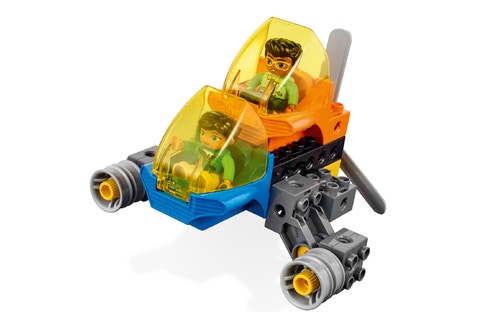Water Vehicles
In this lesson children will investigate water vehicles, compare types of vehicles and talk about the function of propellers and anchors.

Connect
Explain how vehicles that go in the water are different from vehicles that travel on land.
Ask the children to compare a land vehicle (e.g., a car) to a water vehicle (e.g., a boat).
Tell the children that water vehicles often have special elements like propellers that give them the power needed to move on or under the water, or anchors on a pulley system that help prevent them from drifting away.

Construct
Ask the children to work with a partner to design and build a water vehicle.
Assign each pair of children the task of designing and building a water vehicle with a propeller or one with a pulley for an anchor.
Once the children have finished building, have each pair present their underwater vehicle to the group, describing its special element, and explaining what it is used for.
Contemplate
Facilitate a discussion about the children’s water vehicles.
Ask questions like:
- How is your water vehicle different from a land vehicle?
- What might your water vehicle be used for (e.g., fishing, researching marine life, cleaning the
ocean, sightseeing)?
Tell the children that some water vehicles go under the water (i.e., submarines), allowing people to explore parts of the ocean that are not possible to reach in a normal vehicle.
Ask the children to adapt their designs so that their vehicle can go underwater.
Continue
Tell the children that people build all kinds of vehicles for different purposes.
Some go underwater to explore the ocean and some go up in the air to do things like transport people, go on rescue missions, and deliver goods.
Ask the children to work together in their pairs to design and build a flying vehicle like a helicopter, airplane, or even a space shuttle!
Once the children have finished building, have them demonstrate how their models are used.
Did you notice?
Observing the following skills can help you monitor whether the children are developing the necessary competencies:
- Science - Using strategy and planning to solve problems
- Technology - Using technology, such as simple machines in appropriate ways
- Engineering - Investigating, asking questions, making observations, and gathering information to inform the design of machines or tools
- Engineering - Participating in the engineering process by designing, building, and testing models
- Math - Comparing two or more objects or attributes
교사 지원
Children will:
- Investigate water vehicles
- Compare types of vehicles
- Talk about the function of propellers and anchors
- Adapt their designs
For up to 4 children
The learning guidelines from the National Association for the Education of Young Children (NAEYC), Head Start, and the Next Generation Science Standards (NGSS) have been used to develop the Tech Machines lessons. This Teacher Guide focuses on the learning values for math, science, and engineering. Please refer to the learning grid for an overview of the learning values referenced throughout the lessons. The learning goals listed at the end of each lesson can be used to determine whether each child is developing the relevant skills. These bullet points target specific skills or pieces of information that are practiced or presented during each lesson.